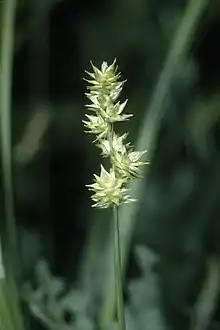| Carex sparganioides | |
|---|---|
 | |
| Scientific classification | |
| Kingdom: | Plantae |
| Clade: | Tracheophytes |
| Clade: | Angiosperms |
| Clade: | Monocots |
| Clade: | Commelinids |
| Order: | Poales |
| Family: | Cyperaceae |
| Genus: | Carex |
| Subgenus: | Carex subg. Vignea |
| Section: | Carex sect. Phaestoglochin |
| Species: | C. sparganioides |
| Binomial name | |
| Carex sparganioides Muhl. ex Willd., 1805 | |
Carex sparganioides, known as bur-reed sedge[1] or loose-headed bracted sedge,[2] is a perennial plant belonging to the sedge family (Cyperaceae). Its native range includes most of the eastern and central United States and eastern Canada.[1] In Maine, it is typically found in hardwood or mixed forests.[3]
It typically grows 30–100 centimeters (12–39 in) high, and contains teardrop-shaped seed sacs within egg-shaped spikelets.[4]
Carex sparganioides is considered endangered in Maine and New Hampshire. It is used for soil stabilization on shaded slopes.[1]
References
- 1 2 3 USDA PLANTS Database
- ↑ Wilhelm, Gerould; Rericha, Laura (2017). Flora of the Chicago Region: A Floristic and Ecological Synthesis. Indiana Academy of Sciences.
- ↑ Maine Department of Conservation Natural Areas Program
- ↑ Young, Dick. Kane County Wild Plants & Natural Areas. 2nd Ed. 1994
This article is issued from Wikipedia. The text is licensed under Creative Commons - Attribution - Sharealike. Additional terms may apply for the media files.